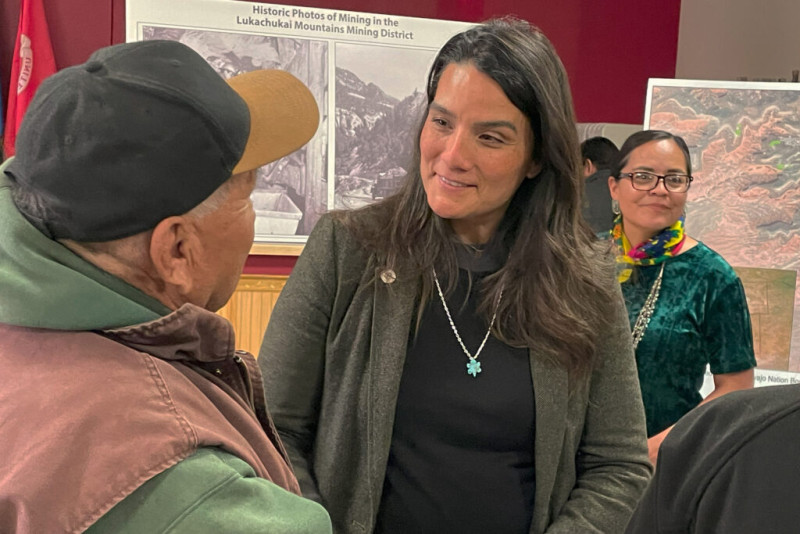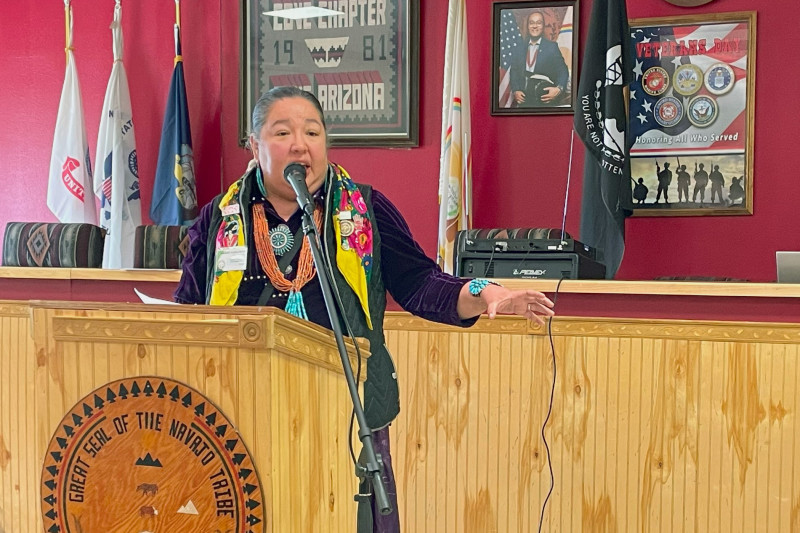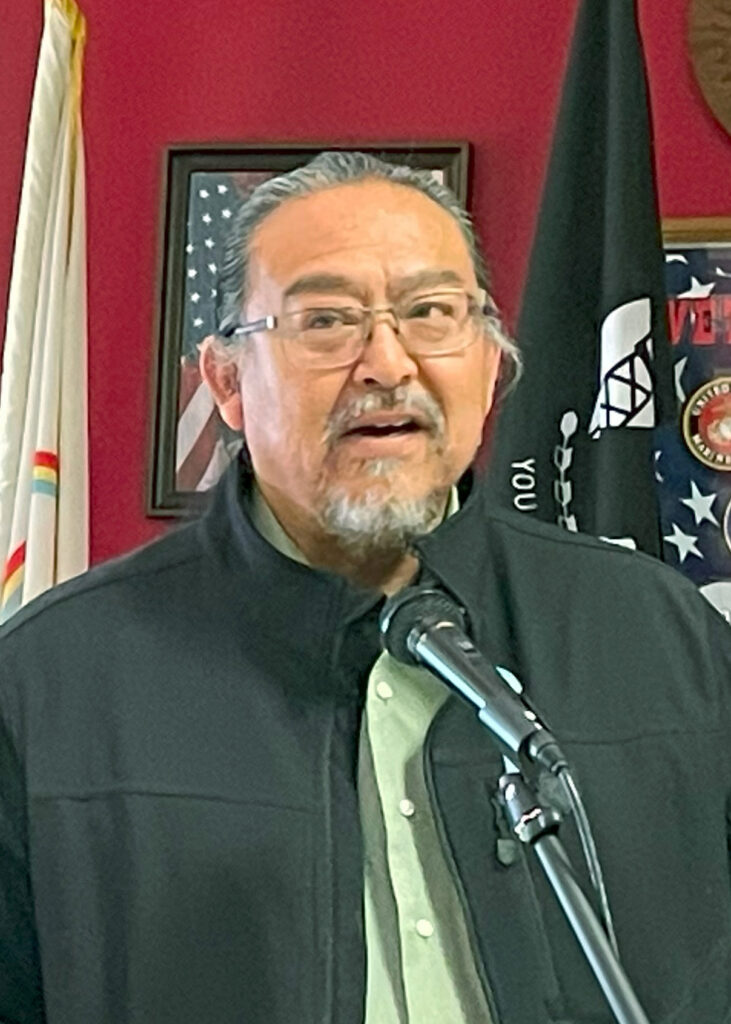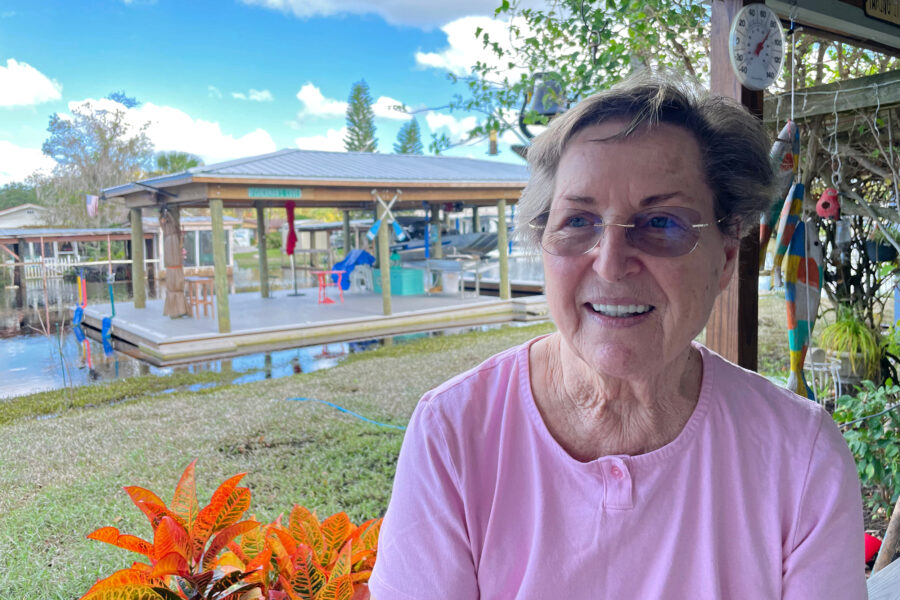This Month’s Superfund Listing of Abandoned Uranium Mines in the Navajo Nation’s Lukachukai Mountains Is a First Step Toward Cleaning Them Up
COVE, Ariz. – In a corner of the Cove Chapter house on March 15, members of the Navajo Nation were silent as they looked at photos the Environmental Protection Agency showed of abandoned uranium mines in the Lukachukai Mountains Mining District during a visit by EPA officials to highlight the area’s placement under the agency’s Superfund program.
The mining district is in northeastern Arizona, on land within the Navajo Nation’s Cove, Lukachukai and Round Rock chapters. Companies with mining claims and leases dug up uranium and vanadium in the area between 1949 and 1968, according to the EPA. Today, there are more than 800,000 cubic yards of mine waste in piles scattered throughout the site.
“Ore was mined using both surface and underground extraction processes, resulting in waste overburden, protore (low-grade mineralized material that surrounds ore) and other contaminated material,” the EPA states in documents.
We’re hiring!
Please take a look at the new openings in our newsroom.
See jobsThis month, the EPA placed the Lukachukai Mountains Mining District on the Superfund National Priorities List—a first for the tribe. It opens the door for money from the federal government to pay for cleanup and remediation work at the sites of mines and tailings piles.
Cove Chapter President James Benally said residents have been affected for 80 years by the mines and waste piles. Men who worked in the mines later died from diseases like cancer, which decimated the male population in the community, he said.
“They went home like that, uranium dust on their clothes,” Benally said. “They slept with our moms like that. We, as kids, played with them like that.”
“Our Navajo people didn’t know about uranium,” said Brenda Jesus, a delegate on the Navajo Nation Council.
But they know the Lukachukai Mountains well. The Diné, as the Navajo identify themselves in their traditional language, hunt game, graze livestock and gather plants for ceremonial and medicinal purposes amid the spiky, sandstone cliffs, sage, juniper and piñon pines in the area. It also provides habitat for the Mexican Spotted Owl, a threatened species under the federal Endangered Species Act.
“The specific herbs and other plant species used by the Diné people for ceremonial and medicinal purposes are held in confidence among tribal members, and thus specific plant community locations are unknown, but prevalent in the Lukachukai Mountains,” according to EPA documents.
Navajo Nation residents who met with EPA officials on March 15 to formally recognize the Superfund designation for the area could see the mountains from the Cove Chapter house.
When Martha Guzman, administrator for the EPA’s Pacific Southwest Region, first visited Cove, she listened to stories from community members about living on the mountains.
“They spoke to me over here in the corner, and shared their stories, shared their experience up in the mountains with their sheep,” she said.
Aside from the federal government’s trust responsibility, placement on the Superfund list will close gaps in the community’s history, Guzman said.


There are 88 abandoned uranium mines in the Lukachukai Mountains Mining District. Settlements with a couple of companies have led to field work and cleanup operations at approximately 40 sites. Across the Navajo Nation lie more than 500 abandoned uranium mines and, according to the EPA, investigations and cleanup are happening at more than 200 of those sites.
Frank James, of Cove, was a boy when his father worked in the uranium mines operated in the community by the Kerr-McGee Corporation. He said his father did not talk about his experience because conveying information about past traumas goes against Diné teachings—the past stays in the past. His father died in 1977, and his death certificate lists lung cancer as the cause of death, he explained.
“I think it’s very important,” James said of the Superfund designation for the mining district.
Repairing and healing the community relies on “trust” and “communication” between the EPA and the tribe, tribal Council Delegate Amber Kanazbah Crotty, who represents Cove and seven other regions, told agency officials.
“This is one step—a Superfund site,” Crotty said.

Placement on the Superfund National Priorities List, several speakers told attendees, was just one of the first steps in a lengthy process that includes further investigation at the site and a feasibility study that could eventually lead to remedial action. But the Lukachukai Mountains will compete with other Superfund sites in Arizona for funding to do that work, Crotty said. So the tribe will need support from Congress, she added.
The Superfund Tax is a source of funding for cleaning up hazardous waste sites when responsible parties cannot pay or cannot be identified. Revenue from the tax goes into a trust fund administered by the EPA.
“We would like to see these remediation activities carried out in a timely fashion, not 40 years from now,” Benally, president of Cove Chapter, said.
Cliff Villa, deputy assistant administrator for the Office of Land and Emergency Management at the EPA, said being on the Superfund site list is a guarantee by the U.S. that Cove will be a national priority for the EPA.
“It is published. It is out there. It is not going away until the job is done,” Villa said. “It is a promise, and it’s an opportunity for resources.”
Last year, Navajo Nation President Buu Nygren voiced his support for the proposal to add the Lukachukai Mountains to the National Priorities List, and former tribal President Jonathan Nez backed the proposal in 2022.
“I support this listing, so long as certain protections are put in place to address the concerns of the local communities that would be affected by designating this site as a Superfund National Priority,” Nygren wrote to Guzman at the EPA in June 2023.

Stephen B. Etsitty, executive director of the Navajo Nation Environmental Protection Agency, said the Nygren administration is committed to securing funds for cleanup activities.
From 1944 to 1989, approximately 30 million tons of uranium ore was removed from mines on or near the Navajo Nation. The dissolved U.S. Atomic Energy Commission was the only entity to buy the mineral until 1966, when commercial sales began.
“We always operate from the standpoint that this is a federal government responsibility,” Etsitty said. “That the federal government should always be doing something every day to fix this problem.”
The Lukachukai Mountains Mining District became a Superfund site on March 5, along with the former Exide Technologies Laureldale in Laureldale, Pennsylvania; Acme Steel Coke Plant in Chicago; Exide Baton Rouge in Baton Rouge, Louisiana; and Lot 46 Valley Gardens TCE in Des Moines, Iowa.
Past activities at these sites include mining of uranium, copper, zinc, lead, silver and gold; lead smelting and refining; coke, molten iron and steel production; and battery manufacturing and recycling, according to the EPA news release about the designations.
“Cleaning up contaminated land and groundwater and returning them for productive use to communities is a win-win-win for our environment, for public health and for the economy,” EPA Administrator Michael S. Regan said in the news release.
Crotty, the tribal council delegate for Cove, looked at a baby in the audience then said the forthcoming cleanup process is being done to benefit the infant and other residents in the mining district.
“It’s also reclaiming our humanity that we deserve to live in a safe community,” Crotty said.
Share this article
Disclaimer: The copyright of this article belongs to the original author. Reposting this article is solely for the purpose of information dissemination and does not constitute any investment advice. If there is any infringement, please contact us immediately. We will make corrections or deletions as necessary. Thank you.







